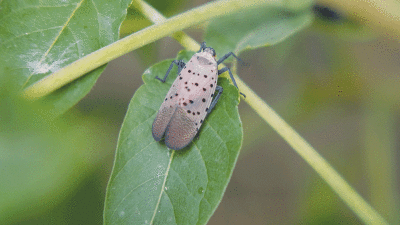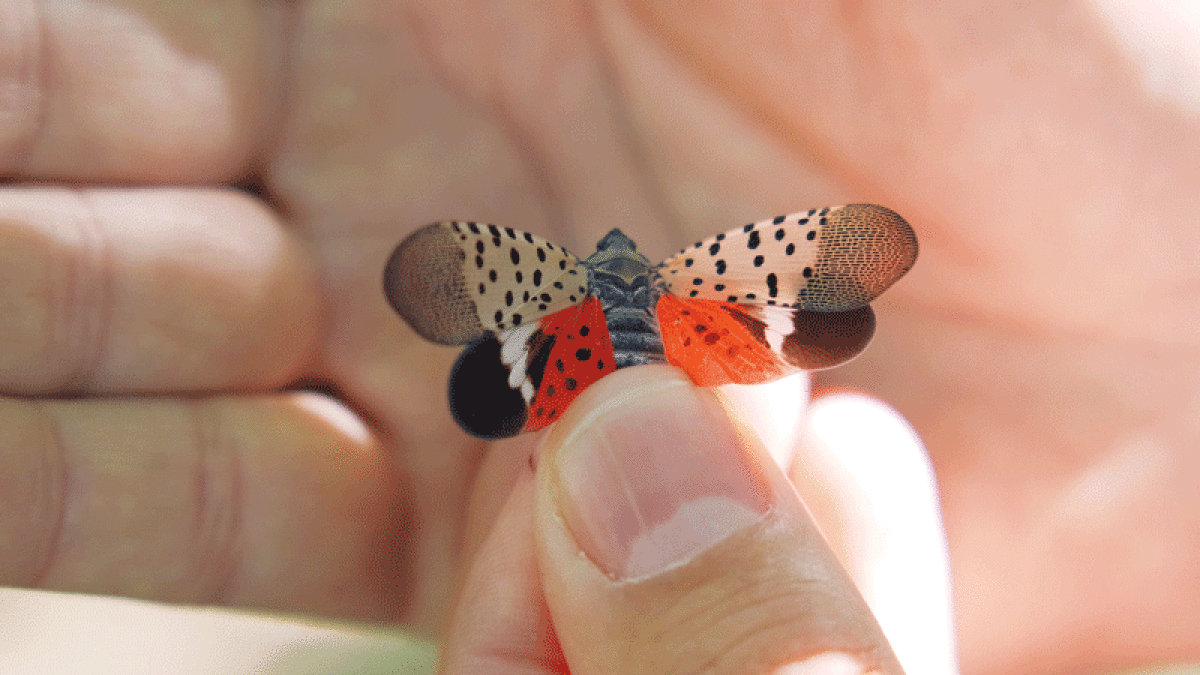
The spotted lanternfly is a pest that can have negative effects on specialty crops.
Photo provided by the Michigan Department of Natural Resources
METRO DETROIT — An invasive fly that’s known to damage crops has made its way to Michigan, threatening the state’s fruit and wine growers.
Native to eastern Asia, the spotted lanternfly was first discovered in the U.S. in 2014, in Pennsylvania. The insect has since spread to several states on the East Coast.
In Michigan, the spotted lanternfly’s first live population was found in Pontiac last year.
“A lot of invasive species come from Eurasia into North America, and they are introduced in shipping. They come in, in a pallet of wood, inside fruit, those kinds of things,” said Tyler Mitchell, the chief of natural resources for the Huron-Clinton Metroparks. “This particular one represents a threat to, primarily, timber, as well as agriculture crops, so it’s a concern for damage of those species — things like grapes, apples and other things that are grown in the region.”
The invasive species, he said, feeds on important Michigan crops, including grapes, apples and hops, although its preferred host plant is the tree of heaven, commonly called ailanthus. While feeding on them, the pest secretes a sugar-rich, sticky liquid called honeydew. Honeydew and the resulting black sooty mold can kill plants and attract other pests that disrupt crop production and harvesting.
Four regional Metroparks — Kensington, Indian Springs, Stony Creek and Wolcott Mill — are located within a 20-mile range of the initial Pontiac infestation. Combined, the parks cover over 14,000 acres and include grasslands, woodlands, wetlands and lakes. The large woodland areas — with populations of tree of heaven, sumac, grape, black walnut and maples — have the potential to create a biomass center for the lanternfly in the region, according to officials.
To get ahead of any potential spread, the Huron-Clinton Metroparks was recently awarded a grant from the Michigan Invasive Species Grant Program to survey its parks for the spotted lanternfly and to treat trees of heaven.
“We’re very excited to receive the grant funding,” Mitchell said. “It really enables us to get out ahead of this problem, and to try to identify any locations where it may spread into neighboring communities, into their timber harvesting areas, or to businesses that grow grapes for wine or apples in orchards, all of those types of businesses.”
The $30,000 grant, Mitchell explained, will allocate $10,000 each year to the cause through 2025. As part of the project, the Metroparks will be working with a contractor to survey the four Metroparks to check for the spotted lanternfly in all stages of its lifespan, followed by removal of trees of heaven.
“Receiving grant funding like this is super important for us to be able to identify these invasive species early, before they take a foothold, and really address the issue before it is a large concern,” said Danielle Mauter, a spokesperson for the Huron-Clinton Metroparks.
The public can help by reporting sightings of spotted lanternfly by taking pictures, if possible, recording the location and trying to collect them in a container. They can then send the information to Michigan’s Eyes in the Field online reporting system or using the Midwest Invasive Species Information Network online reporting tool. If they see a spotted lanternfly in a Metropark, they are encouraged to use the Metroparks-specific form at form.jotform.com/231694898764074.
According to Michigan.gov, here are some tips to identify spotted lanternfly:
· Adults are 1-inch-long leaf hoppers. Folded wings are gray to brown, with black spots.
· Open wings reveal a yellow and black abdomen and bright red hind wings with black spots transitioning to black and white bands at the edge.
· Nymphs are 1/4 inch to 1/2 inch long, wingless and beetle-like, first appearing black with white spots and developing red patches as they mature.
· Egg masses resemble old chewing gum, with a gray, waxy, putty-like coating.
· Hatched eggs appear as brownish, seed-like deposits.
— Source Michigan.gov
 Publication select ▼
Publication select ▼























